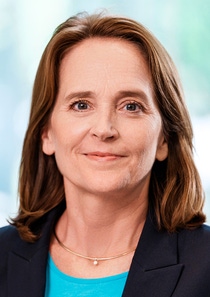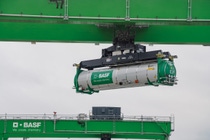Media
Third quarter 2018:
BASF Group increases sales – earnings below prior-year quarter
- Sales grow to €15.6 billion (plus 8%), largely driven by higher sales prices in all segments (plus 6%) as well as higher volumes (plus 2%)
- EBIT before special items of €1.5 billion (minus 14%), mainly due to lower contribution from Chemicals segment
- Net income of €1.2 billion (minus 10%)
2018 outlook adjusted following signing of agreement to merge Wintershall and DEA:
- Slight sales growth
- Slight decrease in EBIT before special items
- Considerable decline in EBIT
In the third quarter of 2018, BASF Group sales rose by 8% year on year to reach €15.6 billion. This was primarily attributable to higher sales prices in all segments. Volumes growth and the acquisition of the Bayer businesses in August 2018 also contributed to the sales increase. Negative currency effects had an offsetting impact. Income from operations (EBIT) before special items declined by €232 million to €1.5 billion, mainly due to the significantly lower contribution from the Chemicals segment. EBIT before special items also decreased considerably in the Functional Materials & Solutions and Agricultural Solutions segments, but fell only slightly in the Performance Products segment. This was partially offset by improved earnings in Other.
Special items in EBIT totaled minus €75 million in the third quarter of 2018, compared with €122 million in the prior-year quarter. In addition to the integration costs incurred in connection with the acquisition of significant businesses and assets from Bayer, expenses for restructuring measures and other charges also contributed here. The prior-year quarter included special income in the Performance Products segment from the transfer of BASF’s leather chemicals business to the Stahl group. Compared to the third quarter of 2017, EBIT therefore declined by €429 million to €1.4 billion. Income from operations before depreciation, amortization and special items (EBITDA before special items) decreased by €254 million to €2.3 billion and EBITDA by €465 million to €2.2 billion.
At the presentation of BASF Group’s quarterly figures, Chairman of the Board of Executive Directors Dr. Martin Brudermüller and Chief Financial Officer Dr. Hans-Ulrich Engel pointed to some of the special factors in the third quarter: “We completed the acquisition of significant businesses and assets from Bayer and reached an agreement on the merger of Wintershall and DEA,” said Brudermüller. After the transaction agreement between BASF and LetterOne was signed, it was necessary to adjust the financial reporting retroactively as of January 1, 2018. The prior-year figures were also restated accordingly.
The low water level in the Rhine River had an impact on business. “Throughout the entire third quarter, we had to struggle with this, which led to production cutbacks and higher transportation costs,” said Brudermüller. And the reporting period is being compared to the BASF Group’s very strong third quarter of 2017, when the business climate was considerably more favorable in comparison. Brudermüller said: “The challenges in the macroeconomic environment are growing. You can see this in our third-quarter 2018 results.”
Outlook for the full year 2018
Growth in industrial production fell short of expectations in the third quarter of 2018, primarily due to developments in the automotive industry in September in particular. The introduction of new emission standards had an impact in Europe. The effects of the trade conflict between the United States and China are also showing. This is leading to a slowdown in economic growth in Asia in particular, mainly in China.
BASF therefore adjusted its assessment of the global economic environment in 2018 as follows (forecast from the BASF Half-Year Financial Report 2018 in parentheses):
- Growth in gross domestic product: 3.0% (3.0%)
- Growth in industrial production: 3.1% (3.2%)
- Growth in chemical production: 3.1% (3.4%)
- Average euro/dollar exchange rate of $1.20 per euro ($1.20 per euro)
- Average Brent blend oil price for the year of $70 per barrel ($70 per barrel)
The signing of the definitive transaction agreement on the merger of Wintershall and DEA reduces the BASF Group’s sales and EBIT by the contribution of its oil and gas activities – retroactively as of January 1, 2018, and with the prior-year figures restated – due to their presentation as discontinued operations.
As a result of this, the BASF Group’s forecast for the full year 2018 made in the 2017 report was adjusted at the end of September (previous forecast from the BASF Report 2017 in parentheses):
- Slight sales growth (slight growth)
- Slight decrease in EBIT before special items (slight increase)
- Considerable decline in EBIT (slight decline)
Business development in the segments in the third quarter 2018
Sales in the Chemicals segment rose by 7% compared with the prior-year quarter to €4.3 billion. This a result of higher prices in all divisions, especially in Petrochemicals. At €851 million, income from operations (EBIT) before special items was down by €251 million versus the strong third quarter of 2017. This was primarily due to lower margins for isocyanates in the Monomers division and steam cracker products in the Petrochemicals division. Earnings were also negatively impacted by higher fixed costs due, among other factors, to increased maintenance expenses. Improved earnings in the Intermediates division were unable to compensate for this.
Sales of around €4 billion in the Performance Products segment were on a level with the prior-year quarter. BASF achieved higher prices in all divisions; however, sales volumes decreased in the Nutrition & Health, Dispersions & Pigments and Care Chemicals divisions. Sales were also weighed down by currency and portfolio effects. Income from operations (EBIT) before special items declined by 6% compared with the third quarter of 2017 to €360 million as a result of lower volumes, higher fixed costs and negative currency effects. Stronger margins had an offsetting effect. Excluding the negative currency effects, EBIT before special items was flat year on year.
In the Functional Materials & Solutions segment, sales rose by 5% compared with the third quarter of 2017 to reach €5.2 billion. This was primarily attributable to higher prices in all divisions, especially in Catalysts and Performance Materials. Volumes also increased, while sales were weighed down by currency effects. Despite volumes growth, EBIT before special items of €347 million was considerably below the level of the prior-year quarter, mainly due to higher fixed costs and lower margins in almost all divisions. However, this BASF segment increased earnings from quarter to quarter over the course of 2018 and continuously reduced the gap to the prior-year quarter.
Sales of €1.2 billion in the Agricultural Solutions segment were up considerably by 26% compared with the third quarter of 2017. This was attributable to portfolio effects from the transaction with Bayer, a higher price level and slightly stronger volumes. Negative currency effects continued to weigh on sales development. Despite the seasonally strongly negative results of the businesses acquired from Bayer, EBIT before special items was down only €26 million on the prior-year quarter. Income generated by BASF operations excluding Bayer activities rose considerably compared with the third quarter of 2017. Excluding the negative currency effects, EBIT before special items also increased slightly overall.
“Following the signing of the agreement with LetterOne, the sales and EBIT of the oil and gas business are no longer included in the respective figures for the BASF Group – retroactively as of January 1, 2018, and with the prior-year figures restated,” said Engel. “These activities are therefore no longer presented as a segment in our reporting.” Until closing, the Wintershall Group’s income after taxes will be presented in the income before minority interests of the BASF Group as a separate item (“income before minority interests from discontinued operations”). In the third quarter of 2018, income before minority interests from discontinued operations increased by €86 million to €235 million. This was mainly attributable to higher prices and volumes as well as an offshore lifting in Libya in the third quarter of 2018; in the previous year, this took place in the second quarter. The price of a barrel of Brent crude oil averaged $75 in the third quarter of 2018 (third quarter of 2017: $52). Gas prices on the European spot markets also saw strong gains compared with the prior-year quarter.
Sales of €827 million in Other were considerably above the prior-year quarter (up 51%), mainly as a result of higher sales volumes and prices in raw materials trading. EBIT before special items improved considerably, from minus €203 million to minus €83 million, primarily as a result of valuation effects from the long-term incentive program.
Development of BASF Group’s earnings and cash flow
Net income declined by €136 million to €1.2 billion. Earnings per share amounted to €1.31 (third quarter of 2017: €1.45). Earnings per share adjusted for special items and amortization of intangible assets were €1.51 (third quarter of 2017: €1.40).
In the third quarter of 2018, cash flows from operating activities amounted to €2.9 billion, €865 million below the figure for the prior-year quarter. This was mainly due to the change in net working capital, in particular the year-on-year increase in cash tied up in inventories and the decline in cash released from receivables. Free cash flow amounted to €2 billion, compared with €2.8 billion in the prior-year quarter.
The BASF Group’s total assets rose by €6.8 billion to €85.6 billion. The acquisition of significant businesses and assets from Bayer contributed €8 billion to this increase. As a result of the purchase price payment to Bayer, net debt increased by €6.5 billion as against December 31, 2017, to €18 billion. The equity ratio of the BASF Group was a solid 43% as of September 30, 2018.
About BASF
At BASF, we create chemistry for a sustainable future. We combine economic success with environmental protection and social responsibility. The more than 115,000 employees in the BASF Group work on contributing to the success of our customers in nearly all sectors and almost every country in the world. Our portfolio is organized into four segments: Chemicals, Performance Products, Functional Materials & Solutions and Agricultural Solutions. BASF generated sales of more than €60 billion in 2017. BASF shares are traded on the stock exchanges in Frankfurt (BAS), London (BFA) and Zurich (BAS). Further information at www.basf.com.
On October 26, 2018, you can obtain further information from the internet at the following addresses:
| Quarterly Statement (from 7:00 a.m. CEST) | |
| basf.com/quarterlystatement | (English) |
| basf.com/quartalsmitteilung | (German) |
| News Release (from 7:00 a.m. CEST) | |
| basf.com/pressrelease | (English) |
| basf.com/pressemitteilungen | (German) |
| Live Transmission (from 9:00 a.m. CEST) | |
| basf.com/pcon | (English) |
| basf.com/pressekonferenz | (German) |
| Speech (from 9:00 a.m. CEST) | |
| basf.com/pcon | (English) |
| basf.com/pressekonferenz | (German) |
|
Live Transmission – Telephone Conference for analysts and investors (from 11:00 a.m. CEST) |
|
| basf.com/share/conferencecall | (English) |
| basf.com/aktie/telefonkonferenz | (German) |
| Photos | |
| basf.com/pressphotos | (English) |
| basf.com/pressefotos | (German) |
| Current TV footage | |
| tvservice.basf.com/en | (English) |
| tvservice.basf.com | (German) |
Receive the latest news releases from BASF via WhatsApp on your smartphone or tablet. Register for our news service at basf.com/whatsapp-news.
Forward-looking statements and forecasts
This release contains forward-looking statements. These statements are based on current estimates and projections of the Board of Executive Directors and currently available information. Forward-looking statements are not guarantees of the future developments and results outlined therein. These are dependent on a number of factors; they involve various risks and uncertainties; and they are based on assumptions that may not prove to be accurate. BASF does not assume any obligation to update the forward-looking statements contained in this release above and beyond the legal requirements.
P-18-343



